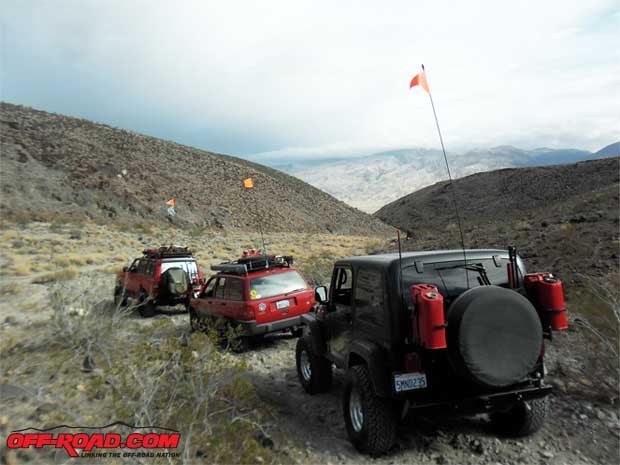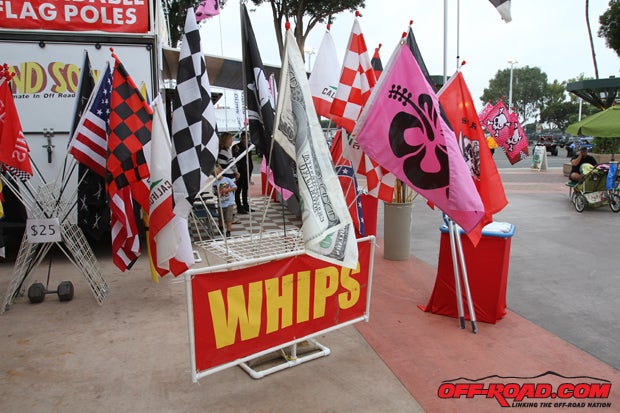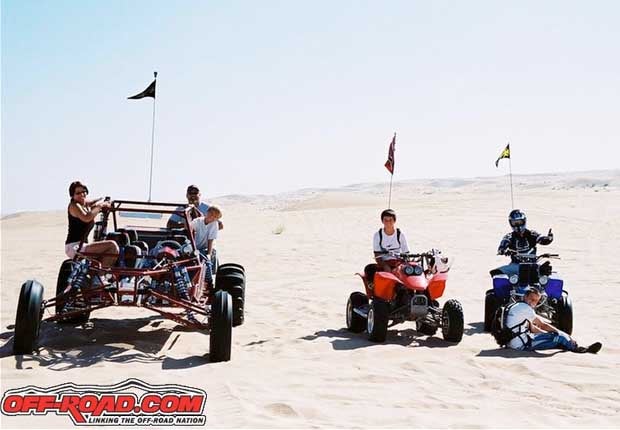
Dune flags are quite popular nowadays. Youíll see all colors and styles, including the American flag, pirate flags, checkerboard flags, rebel flags, ďDonít Tread on Me,Ē and many others. While the driver may be making a statement with his flag, there is also a distinct purpose for the flags.
Those flags add an element of safety to the sport of four wheeling. Strange as it may seem, collisions do occur in wide-open expanses on which we four-wheelers drive. Those flags help you see and be seen.
This is especially true in hilly or dusty environments. Hills naturally block views. Climbing a hill or dune, you canít see whatís on the other side. Is another vehicle coming toward you?
Dust and sand are another problem. While a flag is quite small, if itís bright orange or red, it often can be seen through the haze of dust. Plus, its heightóperhaps six to eight feet above the groundómay place it above most or all of the dust. Iíve witnessed instances when the only thing you could see through the dusty cloud was a couple of flags. Youíd be surprised just how low visibility gets on many trails at higher speeds. (BTW remember Tomís rule: over 10 mph is ďfastĒ off-road! That doesnít mean we canít go fast. Just that the dynamics change.)

An added benefit is that by watching the flags of the vehicles ahead, you can get an idea of the terrain. If you see the flags bobbing up and down, that tells you may be headed for some whoop-dee-doo.
Related to that, itís easier to keep track of the vehicles behind you if they have flags. While in the lead vehicle, I typically can see back at most up to three vehicles. But I can see upwards of a half dozen flags waving behind me. Although the vehicles in my trips are always in radio contact, I also glance in my mirror or over my shoulder frequently to check on the other vehicles progress. Not all drivers travel at the same speed on unfamiliar or difficult terrain. Itís a comforting feeling to look back and see all those flags trailing along knowing the group is together.
At the same time, itís easier for those in the pack to see the lead vehicle. I recommend that the lead vehicle use a distinctive banner so everyone can spot the vehicle. Vehicles can disappear for a short period while going through brush or down a hill. And, as mentioned before, the dune flag might be seen through or above the dust when its vehicle is not.
Rules, Specifications for Dune Flags
Generally speaking, you arenít required to use a dune flag while driving off road. The one exception is on public lands containing sand dunes. The Bureau of Land Management requires banners be solid red or orange in color, at least six inches by 12 inches, and placed such that at least part of the banner is within 10 inches of the top of the whip.
BLM considers a whip to be any pole, rod or antenna mounted on the vehicle that extends at least eight feet from the surface of the ground. It must stand upright when the vehicle is stationary.

Higher quality dune flags and banners (with a pole) usually run about $12 to $15. They can be purchased at any ATV shop, and in most stores and gas stations near off-road areas. As mentioned above, you can use an antenna or most any other whip-like object. You donít need to buy the unit. Just adhere to BLMís rules if youíre driving in dunes.
One thing youíll notice is that the flag or banner doesnít last long if you use it frequently. Wind, rain, dust and the sun take their toll. My flags tend to fray and fade after about one year. The rod or whip might snap on you, especially if you drive a lot in brushy or wooded areas.
How to Attach a Flag
Because there are so many different styles of vehicles, it would be difficult for the manufacturers of dune flags to design a universal mounting bracket. Instead, the rod or pole comes embedded in a 1/2-inch bolt. You need to drill a hole for the bolt; a bumper or other sturdy surface might work. If you use your flag frequently a quick disconnect is handy. You can purchase flags with a quick disconnect or you can build one from an air fitting.
Some Jeep owners tuck the pole against the inside hinge of the tailgate. Closing the tailgate keeps the pole upright and secure. You may need to tinker with your dune flagpole, but you should be able to come up with some way to secure it.
Flags serve a very important safety function in four wheeling. They also allow drivers to express themselves a bit. I encourage you to attach a flag to your vehicle and to use it frequently off-road.
Previous Trail Tips Stories
10 Habits of Highly Admirable 4-Wheelers
How to Replace U-Joints on Your 4x4
Badlands Off-Road Adventure
Off-road trainer Tom Severin shares insight and tips on a variety of topics related to preparing you for that next off-road adventure. With over 40 years of off-road experience, Severin operates under his business Badlands Off-Road Adventures. He is a certified professional 4WD Trainer by the International 4-Wheel Drive Trainers Association and a Wilderness First Responder (WFR). He is a member of the California Association of Four Wheel Drive Clubs (CA4WDC), United Four Wheel Drive Associations and the BlueRibbon Coalition. He also is a certified UFWDA and a CA4WDC 4WD instructor.
For more information about Badlands Off-Road Adventures, visit http://www.4x4training.com/.


 Your Privacy Choices
Your Privacy Choices